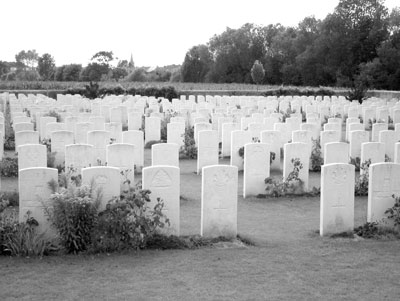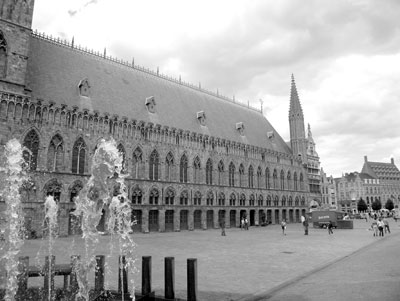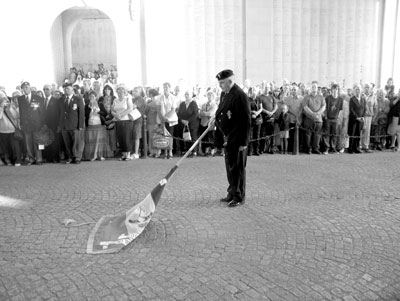Belgium and France with Leger Holidays
“In Flanders fields the poppies blow/Between the crosses, row on row,/That mark our place;…
— from “In Flanders Fields,” John McCrae, 1915
For anyone interested in WWI, the 5-day tour “In Flanders Fields‚ Passchenendaele and the Somme,” organized by Leger Holidays, Ltd. (Sunway House, Canklow Meadows, Rotherham, England S60 2XR; phone 0800 018 9898 or visit www.leger.co.uk), is a must. Our tour, July 18-22, ’05, cost £249 ($437), which included hotel, breakfasts, bus and a superb, knowledgeable guide, Vic Piuk.
At Victoria coach station in London, we boarded the Leger Holiday Silver Service bus to Dover, then took the ferry to Calais and on to the Best Western Ambassador Hotel in Menen, BELGIUM, our base for the next four nights.
In Ypres and the surrounding area, between 1914 and 1918 a quarter of a million soldiers from the United Kingdom and Commonwealth died. Ypres (now called Ieper) was completely leveled in WWI but was beautifully restored as a medieval town. It is a delightful place to visit with its Grote Markt dominated by the Cloth Hall and a 150-foot-high belfry. The town is also a symbol of the senseless suffering and loss of life in WWI.
We made multiple stops, including Passchendaele Ridge, Julian Memorial (a.k.a. the Canadian Memorial), Langemarck (German Cemetery), Tyne Cot (the largest British Military Cemetery in the world, with 12,000 named graves and 35,000 unknowns), Sanctuary Wood, Hooge Crater & Museum, Essex Station cemetery, Artillery Wood Cemetery and the newly opened Yorkshires Trench, where poets Francis Ledwidge and Hedd Wynn are buried.
The Yorkshires Trench and adjacent dugout were only discovered in 1992, and excavations revealed a treasure trove of artifacts together with the remains of 160 Allied and German soldiers. The remains were carefully exhumed and each laid to rest in one of the respective British, French or German cemeteries.
In the evening, before going back to our hotel, we attended the Last Post Ceremony at the Menin Gate in Ypres. Two wreaths of poppies were placed beneath the arch of the gate which bears the names of over 54,896 soldiers missing in action. Observation of this ceremony started on July 1, 1928, and it has taken place every year except during the German occupation in World War II. Originally, it was at sunset, but now it is at
20:00 hours regardless of weather or holidays.
The Last Post is the traditional salute to the fallen warrior. It is performed by retirees or volunteer members of the local fire brigade. For a few minutes, the noise of the traffic ceases, stillness descends on the memorial and everyone present is attentive to the bugler and ceremony — a poignant experience.
The next day we visited the Irish Peace Memorial near Ypres and then traveled into FRANCE to visit Vimy Ridge, heroically taken by Canadian troops in 1917. Lunch was in Arras, and we visited the Arras Memorial to the Missing (35,000 names) before going to the killing ground of Major General Kitchener’s army, the Somme. On the first day of the Battle of the Somme, July 1, 1916, the British sustained 60,000 casualties of which 20,000 were deaths — the worst day in the history of the British army.
We visited the charming town of Péronne and explored its Historical Museum. After lunch in Longueval we went to Devonshire Cemetery, the Lochneger Memorial, the South African Memorial, the Deville Wood Memorial, the Newfoundland Memorial, where we walked through the vast areas of preserved trenches, and finally Thiepval with its enormous Memorial to the Missing (70,000 names).
There are more than 250 military cemeteries and memorials on the Western Front, and it is the responsibility of the Commonwealth War Graves Commission to maintain them. Two unique features of the WWI cemeteries are the “Cross of Sacrifice,” made of Portland stone from the south of England, and the “Stone of Remembrance,” also Portland stone and inscribed with the words, “Their name liveth forevermore.”
Today the battlefields have been replaced by beautiful rolling farmland, but it is still possible in some areas to see signs of the war fought 90 years ago. In some areas, shell holes are still very evident, as are the trenches. Unexploded ordnance is common, and so large areas are still No Man’s Land.
Remains of MIAs are still being found at the rate of 20 to 30 per year, and this has become known as the “Harvest of Bones,” a piercing reminder of the senseless slaughter of human life that occurred on the Western Front between 1914 and 1918.
— BERNARD GOODHEAD, La Jolla, CA



